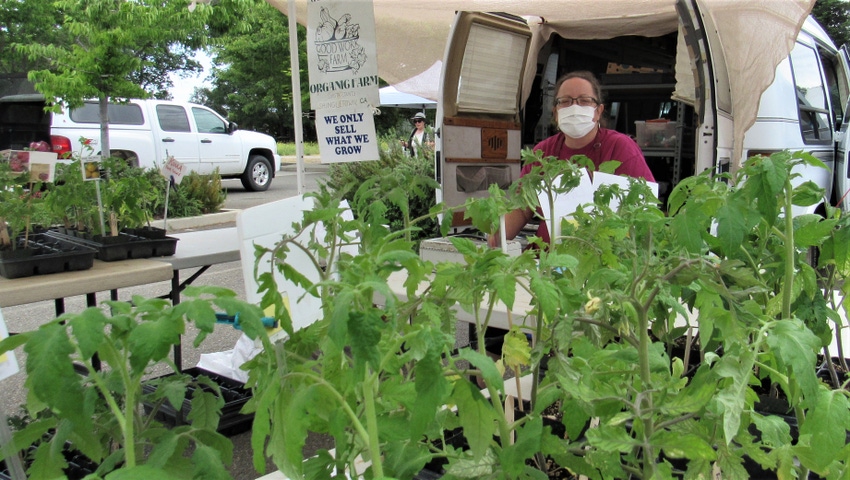
Like many small farms that sell directly to consumers, Margaret Jensen’s Good Work Farm in Shingletown, Calif., was a little unprepared for this spring’s onslaught.
“Everyone’s growing a garden. We can’t keep up with the demand for the most popular ones,” Jensen said as she sold numerous plant seedlings recently at a farmers’ market in Redding, Calif.
The hottest-selling plants have been zucchini, red cherry tomatoes and even some more exotic tomatoes, she said.
“Had we known we would have had this situation, we would have planted twice as many seedlings in February,” Jensen said.
Her farm isn’t alone. As the coronavirus outbreak has led to shuttered restaurants and made some people think twice about entering crowded grocery stores, direct sales from farms to consumers has skyrocketed, industry representatives say.
“More recently, I think people are valuing more local food,” said Audrey Pascone of Red Gate Ranch in Red Bluff, Calif., who was selling fresh pork sausage and other goods at the Redding market.
“I think reliability is a big piece now, too,” she said. “It kind of frightened everyone when shelves were empty.”
CSA membership boom
In early March, the Davis, Calif.-based nonprofit Community Alliance with Family Farmers was helping area community-supported agriculture businesses, or CSA’s, that were struggling to find customers for their direct-sales operations. But that need soon evaporated, noted Evan Wiig, CAFF’s director of membership and communications.
“Never in the history of CSA has there been such a spike in membership,” Wiig told Western Farm Press in an email. “Here in my neck of the woods, the North Bay, I can safely say that 99 percent of CSA’s were full by the middle of April, which has never happened.
“Likewise, for those who had e-commerce and other direct sales outlets already set up, they’ve seen a huge spike, too,” he said. “And many farmers who were previously selling to restaurants, cafeterias and other outlets that have shut down are now scrambling to pivot, which admittedly is easier for some than others.”
CAFF is now “acting like a matchmaker,” connecting those seeking direct deliveries from farms with producers who have unclaimed food to sell, Wiig said.
The organization has set up a donor-supported emergency fund to help small farmers, many of whom have struggled from the closure of restaurants that were featuring their goods. On May 14, the organization gave out its first 24 “micro-grants” totaling $60,000, with plans to award more in subsequent weeks.
Other farms adapt
Some farms that weren’t normally involved in direct-to-consumer sales have adapted to meet the burgeoning demand. As restaurants, food services and workplaces shut down, growers and distributors that had been selling primarily to restaurants and institutions scrambled for new marketing channels, said Penny Leff, a University of California agritourism coordinator and public education specialist.
“For many small-scale growers, this meant finding ways to sell directly – and often to customers in their own communities,” Leff said.
Farmers’ markets in some areas have been busy, while others in different locations saw sales drop as some were afraid to go out to them for fear of catching COVID-19, she said in an email.
“Luckily, consumers staying at home were looking for access to fresh produce and other food delivered to their home,” Leff said. “Also, I think, city people noticed that farmers were still working and maybe city people noticed that food comes from farms before it gets to the store, and also there’s a new interest in cooking and gardening.”
Many new box delivery programs have developed quickly – some as partnerships among farmers and some in partnerships with nonprofits and emergency food programs, Leff said.
On May 1, the health care provider UnitedAg announced that two of its member farms – fresh produce wholesalers Rancho Guadalupe of Santa Maria and Dynasty Farms of Salinas – were beginning to sell low-cost produce to the Alameda County Community Food Bank.
“When the COVID-19 crisis hit, and the food service operations all came to a standstill overnight, millions of jobs were lost and with it the demand for our produce,” said A.J. Cisney, general manager of Rancho Guadalupe.
“To bring more diverse options to the food bank, and at the same time recover our cost to grow and harvest it, creative solutions were necessary to take care of those who need it most and help keep agriculture whole,” Cisney said.
Will it last?
Will the popularity of direct-to-consumer sales last? Wiig suspects there will be a drop in CSA members once things start returning to normal, but the crisis exposed more people to CSA’s than were familiar with them before.
“More people now appreciate the value of shortening the supply chain, knowing your farmer and getting healthy, locally grown food,” Wiig said. “So in that sense, I think there will be lasting impact.”
In the case of gardens, Good Work Farm’s Jensen believes many people have been talking about reinvigorating their garden for years and this was their chance to do it. The UC reports sign-ups to its Master Gardeners webinars have been booming.
“Everyone is gardening,” Jensen said. “The weather has been perfect. It’s hard to remember a better spring for growing plants well.”
About the Author(s)
You May Also Like






